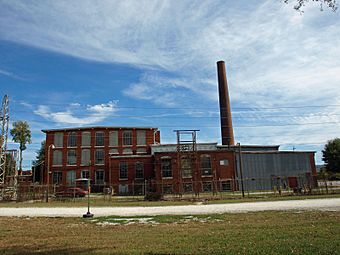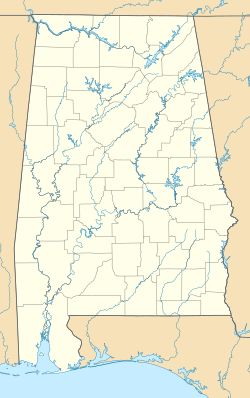Lowe Mill facts for kids
Quick facts for kids |
|
|
Lowe Mill and Mill Village Historic District
|
|

Lowe Mill in October 2011
|
|
| Location | Triana Blvd. SW., 10th Ave. SW., Summer St. & Governor's Dr., Huntsville, Alabama |
|---|---|
| Built | 1900 |
| Architect | C. R. Makepeace & Co. |
| NRHP reference No. | 11000375 |
| Added to NRHP | June 24, 2011 |
Lowe Mill is a huge building in Huntsville, Alabama, that used to be a cotton mill. A cotton mill is a factory where raw cotton is spun into thread and then woven into fabric. This building is about 171,000 square feet!
Today, it's known as Lowe Mill ARTS & Entertainment. It's the biggest privately owned place for artists and creative people in the United States.
Contents
A Look Back at Lowe Mill's History
The Mill's Early Days
In 1900, a man named Arthur H. Lowe started the Lowe Manufacturing Company. He began building Huntsville's fifth textile mill, which is a factory that makes cloth. Lowe Mill opened in 1901. It had 25,000 "spindles," which are parts of machines that twist cotton into thread. This thread was then woven into cloth.
In 1902, another company, Eastern Manufacturing Company, built a weaving mill nearby. This mill made high-quality fabrics like ginghams and shirt materials. In 1904, Lowe Mill and Eastern Manufacturing joined together. Lowe Mill made the yarn, and the Eastern mill used it to weave cloth.
Changes Over the Years
In December 1932, during a tough economic time called the Great Depression, Lowe Manufacturing Company went out of business. But the factory quickly reopened in January 1933 as Lowe Mills, Inc. Donald Comer, who led Avondale Mills in Birmingham, Alabama, became the main owner.
In 1936, Lowe Mill changed hands again. Edwin Greene from New York became the main owner, and the company was renamed Lowe Corporation. However, in March 1937, the company closed down. The buildings were sold to Walter Laxson and became a warehouse for storing cotton.
From Shoes to Art
After World War II, in December 1945, a company called General Shoe Co. opened a shoe factory at Lowe Mill. It employed up to 800 people! In 1959, General Shoe Co. changed its name to Genesco, Inc. Many US soldiers fighting in Vietnam wore boots made at this Huntsville factory.
In 1978, Genesco sold the mill. Martin Industries then used Lowe Mill as a warehouse for heating systems. In 1999, a real estate agent named Gene McLain bought Lowe Mill. Then, in 2001, he sold it to Jim Hudson, who started Research Genetics. Jim Hudson still owns Lowe Mill today.
Now, Lowe Mill ARTS & Entertainment provides studio and exhibition space for over 200 artists. The mill and the area around it were added to the National Register of Historic Places in 2011. This means it's recognized as an important historical site.
Lowe Mill Timeline
- 1900: Arthur H. Lowe plans to build Lowe Manufacturing Company, Huntsville's fifth cotton mill.
- 1901: Lowe Mill opens for making textiles. It spins local cotton into fibers and yarn.
- 1902: Eastern Manufacturing Company builds a weaving mill next door. It uses Lowe Mill's yarn to make high-quality clothes.
- 1904: Lowe Mill and Eastern Manufacturing Company merge. The two buildings are joined together.
- 1907: The companies officially combine into Lowe Manufacturing, Inc.
- 1911: Hunter Manufacturing Co. takes over Eastern Manufacturing, but the mill keeps running as "Lowe Mill."
- 1932: Lowe Manufacturing Company goes bankrupt during the Great Depression.
- 1933: The mill reopens as Lowe Mills, Inc. in January.
- 1937: Textile manufacturing stops. The buildings are sold and used as a cotton warehouse.
- 1946: General Shoe Company opens a shoe factory in the mill.
- 1959: General Shoe changes its name to Genesco.
- 1960s: Genesco makes many combat boots for US soldiers during the Vietnam War.
- 1978: Genesco closes its factory. Martin Industries turns Lowe Mill into a warehouse for heating systems.
- 2001: Jim Hudson buys Lowe Mill, giving it new life.
- 2004: The Flying Monkey Arts Center opens on the second floor of the South building.
- 2008: Studios open on the second-floor connector building.
- 2009: The third floor opens for Lowe Mill ARTS & Entertainment, LLC.
- 2010: The first-floor studios in the South building open to the public.
- 2012-2013: More studios and businesses open, including Vertical House Records and Pizzelle's Confections.
- 2014: The second floor of the North building opens. This makes Lowe Mill A&E the largest privately owned arts and entertainment facility in the United States, with over 200 working artists.



